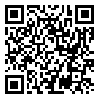Volume 64, Issue 12 (6 2006)
Tehran Univ Med J 2006, 64(12): 38-47 |
Back to browse issues page
Download citation:
BibTeX | RIS | EndNote | Medlars | ProCite | Reference Manager | RefWorks
Send citation to:



BibTeX | RIS | EndNote | Medlars | ProCite | Reference Manager | RefWorks
Send citation to:
Afsarian SMH, Zaini F, Kordbacheh P, Mahmoudi M, Rezaii S, Safara M. Identification and study of non-Albicans Candida species isolated from clinical materials of patients with Candidiasis. Tehran Univ Med J 2006; 64 (12) :38-47
URL: http://tumj.tums.ac.ir/article-1-858-en.html
URL: http://tumj.tums.ac.ir/article-1-858-en.html
Abstract: (12684 Views)
Background: I Infections due to Candida spp. have increased dramatically in recent years through a rising number of predisposing factors and immunocompromised hosts. Although Candida albicans is the most prevalent and important causative agent of Candida infections, the importance of C. parapsilosis, C. tropicalis, C. krusei, C. glabrata, C. guilliermondii and C. kefyr have increased significantly as they tend to be more resistant to antifungal agents. Therefore, it is critical that infecting Candida spp. be identified and considered. Furthermore, clinical laboratories may need to expand their yeast identification capabilities in order to facilitate rapid identification of clinical yeast isolates.
Methods: In a discroptive – analytic study, the patients suspected of candidiasis were sampled. Direct examination and culture was carried out for all specimens. The isolated yeast colonies were then identified using various different tests such as culture on corn mealagar tween-80, CHROMagar Candida, and assimilation test by API 20C AUX kit.
Results: In the present study, 304 yeast colonies were isolated from referral patients to mycology laboratory of 304 isolated colonies 204 were identified as C. albicans and 100 were identified as non albicans candida as follow 35% C. parapsilosis, 32% C. tropicalis, 8% C. glabrata, 8% C. kefyer, 6% C. krusei, 3% C. guilliermondii, 3% C. famata, 3% C. lusitaniae, 1% C. zeilanoides and 1% C. homicola. C. parapsilosis was the most frequent species. The result showed that clinical specimens were obtained from various infected sites of body and nail samples (59 cases) were found to be the most frequent among those specimens.
Conclusion: In conclusion, our results suggest that no single phenotypic test has proven to be highly effective for definitive identification. Moreover since these organisms can vary greatly in their susceptibility to the current antifungal agent and causing significant patient management problem therefore evaluation of susceptibility of these isolates against antifungal drugs is need to be investigated.
Methods: In a discroptive – analytic study, the patients suspected of candidiasis were sampled. Direct examination and culture was carried out for all specimens. The isolated yeast colonies were then identified using various different tests such as culture on corn mealagar tween-80, CHROMagar Candida, and assimilation test by API 20C AUX kit.
Results: In the present study, 304 yeast colonies were isolated from referral patients to mycology laboratory of 304 isolated colonies 204 were identified as C. albicans and 100 were identified as non albicans candida as follow 35% C. parapsilosis, 32% C. tropicalis, 8% C. glabrata, 8% C. kefyer, 6% C. krusei, 3% C. guilliermondii, 3% C. famata, 3% C. lusitaniae, 1% C. zeilanoides and 1% C. homicola. C. parapsilosis was the most frequent species. The result showed that clinical specimens were obtained from various infected sites of body and nail samples (59 cases) were found to be the most frequent among those specimens.
Conclusion: In conclusion, our results suggest that no single phenotypic test has proven to be highly effective for definitive identification. Moreover since these organisms can vary greatly in their susceptibility to the current antifungal agent and causing significant patient management problem therefore evaluation of susceptibility of these isolates against antifungal drugs is need to be investigated.
| Rights and permissions | |
 |
This work is licensed under a Creative Commons Attribution-NonCommercial 4.0 International License. |





